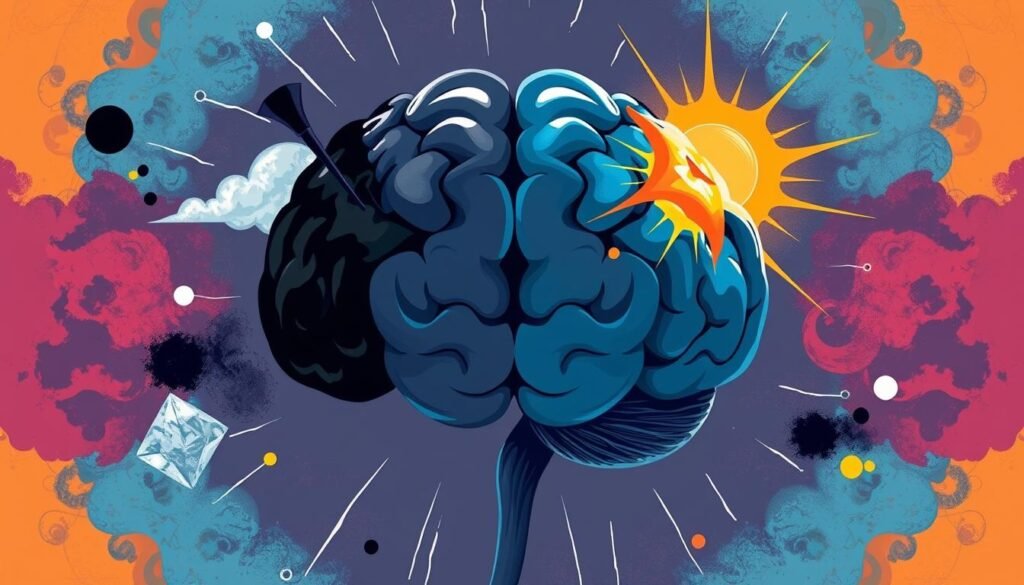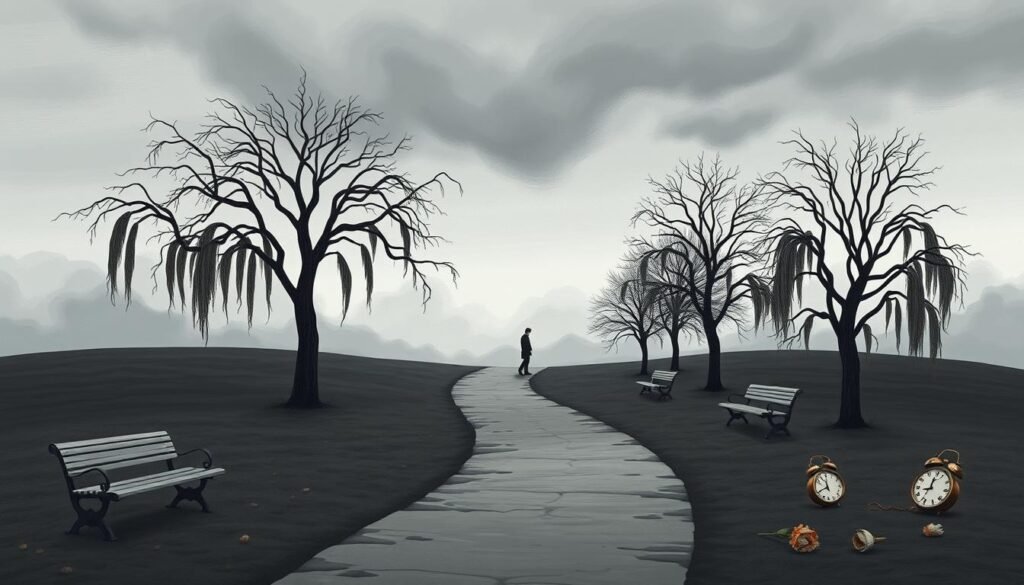Did you know nearly 17.3 million adults in the United States struggle with depression every year? This shows how common mood disorders are, affecting many people’s daily lives. Depression isn’t just about feeling sad. It has many forms and symptoms. These change how people think, feel, and act. This guide will help you understand depression’s biological roots in the brain. You’ll learn about its link to brain chemistry, risk factors, and how to treat it effectively.
This guide dives deep into depression’s complexities, aiming to inform and give hope. It is for those looking for ways to better manage their mental health. We’ll explore the fascinating world of depression together. With the right knowledge, we can promote awareness and well-being.
Key Takeaways
- Depression affects about 7.1% of all U.S. adults.
- Major Depressive Disorder is the leading cause of disability globally.
- Brain chemistry plays a critical role in understanding mood disorders.
- Numerous treatment options exist, ranging from medication to therapy.
- Risk factors for depression include genetic and environmental influences.
- Neuroimaging studies provide valuable insights into brain abnormalities linked to depression.
- Support systems and healthy coping strategies are crucial for managing depression.
What is Depression?
Depression hits people in many ways with emotions like sadness, hopelessness, and lack of interest in life. It can impact anyone, regardless of age or background, and messes with how they handle life. Knowing about major depression, its forms, and symptoms helps us address it better.
Defining Major Depression
Major depression, also known as Major Depressive Disorder (MDD), brings a lasting sad mood and disinterest in activities. It’s diagnosed when someone feels this way for more than two weeks. Affected people feel worthless, tired, and find it hard to focus, which harms their everyday life.
Types of Depression
Depression comes in different types, including:
- Persistent Depressive Disorder: This long-term form can last years.
- Perinatal Depression: Happens during or after having a baby.
- Seasonal Affective Disorder (SAD): Related to changes in the season, often getting worse in winter.
- Bipolar Disorder: Features periods of depression and high energy or mania.
Symptoms and Diagnosis
Spotting depression signs is key for finding it. Usual signs include:
- Feeling hopeless
- Being really tired or lacking energy
- Big changes in how much you eat or weigh
- Struggling to concentrate
Doctors diagnose depression by looking carefully at how long and serious symptoms are, and how they change someone’s life. They might use special tests or talk to learn more about these depression signs.
How Common is Depression?
It’s important to know how widespread depression is. Many studies show it’s quite common, touching many lives. This information helps create better support for those affected.
Statistics on Mental Health
More than 17 million adults in the U.S. have had major depressive disorder. A 2018 study found it’s linked to less gray matter in the brain. Changes in brain chemicals and inflammation make it more complex.
Demographics Affected by Depression
Depression hits some groups harder than others. About 2-8% of adults will face major depressive disorder, with women more at risk. Young and older people also see higher rates, pointing to the need for specific help.
People with recurrent brief depression face challenges often. They may have many episodes a year, making daily life harder.
The Biological Basis of Depression
To grasp the biological roots of depression, we explore brain chemistry and neurotransmitters. Many things like genes, surroundings, and past experiences can influence these intricate systems. These in turn can lead to depression.
Understanding Brain Chemistry
Brain chemistry is crucial for managing feelings and mental well-being. Neurotransmitters, such as serotonin, dopamine, and norepinephrine, play vital roles in mood regulation. If their levels shift, this might trigger depression symptoms. A surprising 85% of surveyed people think that chemical imbalances affect depression. Yet, a study in the 2023 issue of Molecular Psychiatry suggests it’s not just about chemical imbalance. Traumatic events can also make someone more prone to depression.
The Role of Neurotransmitters
Serotonin, norepinephrine, and dopamine are key neurotransmitters linked to depression. They each have a part in controlling mood and depression signs. Serotonin deals with sleep and mood; norepinephrine with energy and stress; Dopamine with pleasure and rewards. If their levels change, it can really impact how someone feels. For instance, not having enough serotonin or norepinephrine can cause ongoing depression symptoms. This can make things hard at work or home.
While serotonin, norepinephrine, and dopamine are well-studied, scientists are still learning about others like glutamate and GABA. They are looking into how these affect depression too. Antidepressants, especially SSRIs like Prozac, work by boosting neurotransmitter levels to better mood and relieve symptoms. Understanding depression’s biology is key to developing effective treatments. It shows why it’s so important to continue research in brain chemistry and its effect on mental health.
Depression in the Brain
Depression changes how the brain works deeply. It impacts neuroplasticity, the brain’s ability to change and rearrange itself. The way brain structures connect is important in seeing how depression affects the brain. We learn more about mood disorders by looking at how these changes affect feelings and thinking.
Neuroplasticity and Depression
Neuroplasticity is key in fighting depression. People with depression often have less neuroplasticity. This makes it harder for their brains to recover. Stressful environments can make this worse, pushing some into deeper depression.
Impact on Brain Structures
Depression changes important brain areas like the hippocampus and amygdala, which affect memory and emotions. For example, in those with depression, the amygdala reacts more to negative emotions. Meanwhile, the Nucleus Accumbens (NAc) is less active in how it processes rewards. These changes hurt mood and can also worsen thinking skills over time.
| Brain Structure | Effects of Depression |
|---|---|
| Hippocampus | Loss of gray matter volume, affecting memory and learning. |
| Amygdala | Increased activity related to negative emotions. |
| Nucleus Accumbens | Reduced response to rewarding stimuli, contributing to anhedonia. |
| Prefrontal Cortex | Impacts executive functions and decision-making abilities. |
Understanding these brain changes is crucial for creating effective treatments. For more on how depression affects brain and mental health, visit here.

Neurotransmitters and Depression
Neurotransmitters are vital for mood and emotions. Serotonin and dopamine are especially important. They help us understand depression and how to treat it. When these chemicals are off balance, depression can happen.
The Functions of Serotonin
Serotonin makes us feel good. It controls mood, anxiety, and happiness. When serotonin is low, depression can occur. This has led to treatments that increase serotonin. Drugs called SSRIs can help stabilize mood.
The Role of Dopamine
Dopamine lets us feel pleasure and satisfaction. Not having enough dopamine causes lack of motivation. This is a symptom of depression. Treatments that balance dopamine can improve emotions. This opens new paths for treating depression, offering hope to many.
| Neurotransmitter | Main Function | Relation to Depression | Treatment Focus |
|---|---|---|---|
| Serotonin | Regulates mood, anxiety, and happiness | Low levels are linked to depressive symptoms | SSRIs are primary treatment options |
| Dopamine | Affects pleasure and reward pathways | Low levels lead to decreased motivation | Dopamine-targeted therapies are being explored |
Understanding the Risk Factors
Depression comes from many factors that can make it much worse or a bit better. Studies show that genes and what happens to us play big roles. Knowing these factors helps in stopping depression early and finding good treatments.
Genetic Factors
Genes are big in figuring out who gets depressed. About 40% of depression could come from our DNA. If depression runs in the family, the risk goes up. For example, if one twin gets depressed, the other twin has a 70% chance to get it too.
Environmental Influences
Tough times, being alone a lot, and constant stress can really affect our minds. Bad stuff happening when we’re little or big stresses like losing a job can push us towards depression. Being isolated a lot is another big reason people get depressed. It shows why having friends and family around is key.
- Life changes such as moving or retiring
- Traumatic life experiences
- Chronic health conditions
- Substance use and abuse
Looking closely at depression’s risk factors helps us get it and act early. This makes life better for those who might get depression.

| Factor | Effect on Depression |
|---|---|
| Genetic History | Increases likelihood significantly |
| Chronic Illness | Higher rates of depression |
| Social Isolation | Common source of depression |
| Traumatic Events | Triggers depressive episodes |
| Substance Abuse | Increases risk through brain chemistry changes |
Cognitive Impairment and Depression
Depression deeply affects how we think. It leads to trouble with memory, focusing, and making choices. Most people with major depressive disorder find thinking clearly hard. About 85–94% of them struggle with this during their low periods. This shows how widespread depression effects on cognition are.
These thinking problems make depression feel worse. People feel stuck and this makes getting better harder. Studies show that 20% end up with long-term depression. This makes memory and thinking issues more likely.
Older adults are at big risk. In Europe, 10–15% of seniors are depressed. This number jumps to 54% in nursing homes. For them, thinking problems could hint at dementia. This is especially true for those with worse depression.
Checking cognitive function is key in treating depression. It helps improve mental health and life quality. Spotting and dealing with these issues is critical for recovery.
Treatment Options for Depression
Treating depression means finding what works for each person. This can include talking to a therapist, taking medication, and sometimes, brain stimulation. Knowing all the ways to deal with depression is key to getting better.
Psychotherapy Approaches
Psychotherapy is a big part of fighting depression. It uses methods like cognitive behavioral therapy (CBT) and interpersonal therapy (IPT). These methods help fix negative thoughts and social problems. They can be done face-to-face or online. This makes it easier for people to get help. Research shows that the best results come from combining talk therapy with medicine.
Pharmacological Treatments
Drugs for depression aim to fix the brain chemicals that affect mood. Doctors often prescribe SSRIs and SNRIs. It can take about four to eight weeks to see if they work. For those who don’t do well with usual treatments, doctors might use pharmacogenetic testing. This helps find the best drug for each person.
Brain Stimulation Therapies
If standard treatments don’t work, there are other options. Brain stimulation like repetitive transcranial magnetic stimulation (rTMS) and electroconvulsive therapy (ECT) might help. ECT is an older method but can really help severe depression. But, it might cause confusion and memory troubles. rTMS is less intense and is done over several weeks. It could cause headaches but is generally milder.

| Treatment Method | Description | Typical Duration | Common Side Effects |
|---|---|---|---|
| Psychotherapy | Cognitive behavioral therapy (CBT), interpersonal therapy (IPT) | Varies | Fatigue, emotional discomfort |
| SSRIs/SNRIs | Medications that target neurotransmitter imbalances | 4-8 weeks to see full effects | Nausea, insomnia, headaches |
| rTMS | Non-invasive brain stimulation method | 30-40 minutes per session, usually over a month | Headache, lightheadedness, facial spasms |
| ECT | Involves electrostimulation to relieve severe depression | 2-3 times weekly for 6-12 treatments | Memory loss, confusion, headache |
Managing Mood Disorders
To manage mood disorders well, healthy habits are key. This helps lessen symptoms and supports recovery. Using the right techniques can boost mental health and resilience.
Developing Healthy Coping Strategies
Coping strategies are vital in tackling mood disorders. They help boost emotional health. Here are some:
- Mindfulness practices encourage staying in the moment.
- Regular exercise boosts mood with endorphin release.
- Establishing healthy sleep patterns is key for mental stability.
- Maintaining social connections with loved ones provides support.
Joining self-management education programs is beneficial. It helps individuals handle their symptoms and make personal plans. Using various strategies tailored to their needs vastly improves life for those affected.
The Importance of Support Systems
For those facing mood disorders, support systems are crucial. They provide encouragement and understanding. A network of family, friends, and professionals is key.
Getting support helps fight loneliness and boosts emotional health. Family therapy, for instance, improves communication and support. Adults with mood disorders find relief through treatments like antidepressants and psychotherapy. These, along with strong support networks, help manage symptoms. This improves all parts of life, from personal connections to job performance. Learning and using resources is essential for managing mood disorders effectively.
Conclusion
Learning how depression works in the brain is key to handling it better. Major depressive disorder (MDD) has a significant impact. It affects 16.2% of people at some point and 6.6% in any given year. Knowing about depression helps people spot signs early and get help, leading to recovery.
Studies show depression comes from not just one cause, but many. It’s a mix of biological, environmental, and psychological elements. The idea that just a lack of serotonin causes it is outdated. Understanding the broad reasons behind mood disorders helps people in their healing. It also fights mental health stigma.
Research like the STAR*D Project shows that many with MDD will have it more than once. A staggering 73% of patients face repeated episodes. This fact emphasizes the need for ongoing awareness about depression. Long-term care strategies are crucial. They help improve life for those struggling with depression.